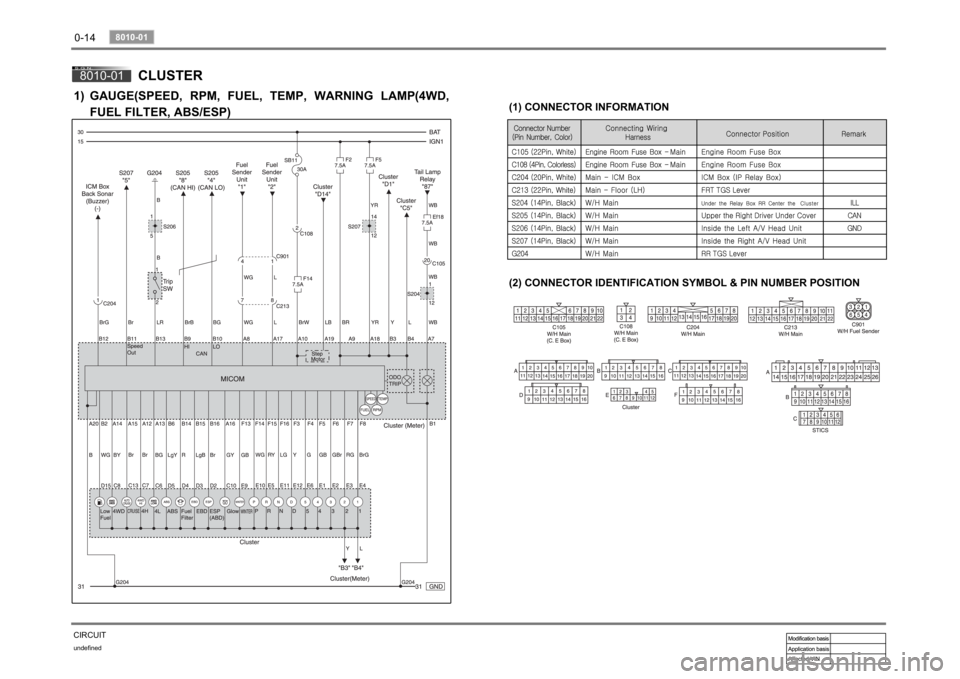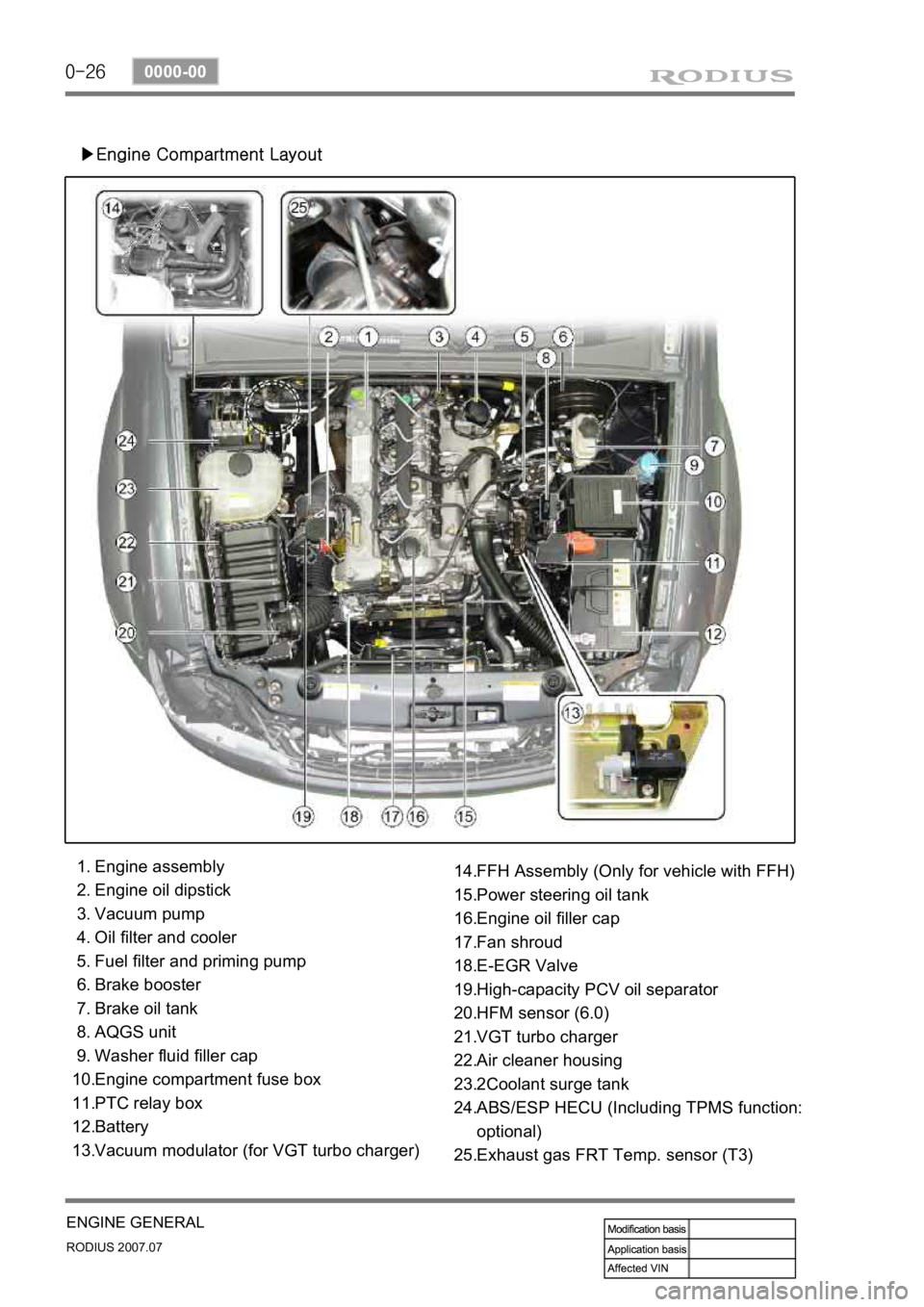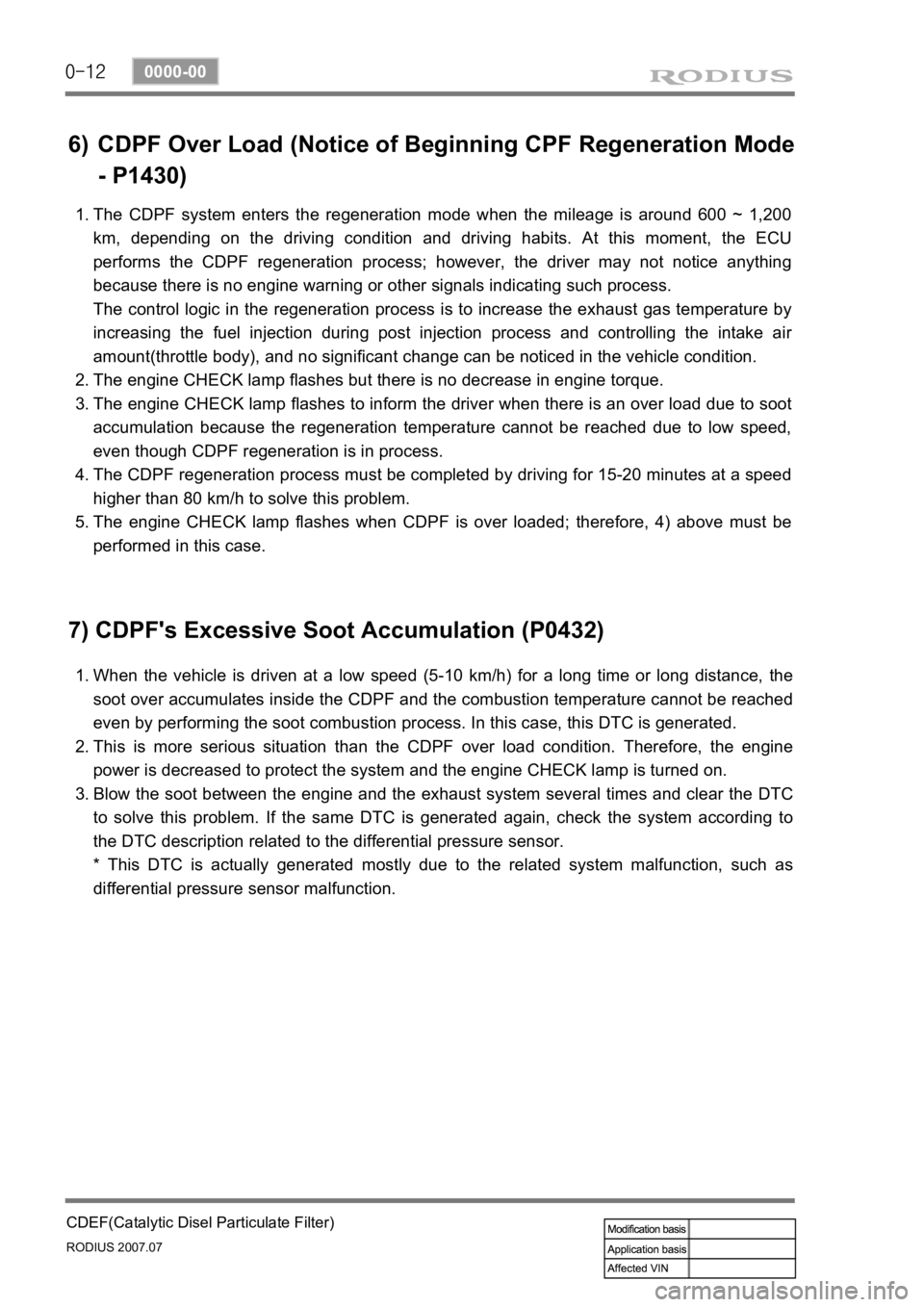fuel filter SSANGYONG RODIUS 2006 Service Manual
[x] Cancel search | Manufacturer: SSANGYONG, Model Year: 2006, Model line: RODIUS, Model: SSANGYONG RODIUS 2006Pages: 444, PDF Size: 56.32 MB
Page 28 of 444

0-4undefined
1491-01
CIRCUIT2) FUEL FILTER WARNING LAMP, IMMO, SENSOR (FUEL
PRESSURE, CAM SHAFT, BOOSTER PRESSURE, CRANK
SHAFT, COOLANT/FUEL TEMP.)
(2) CONNECTOR IDENTIFICATION SYMBOL & PIN NUMBER POSITION (1) CONNECTOR INFORMATION
Page 38 of 444

0-14undefined
8010-01
CIRCUIT8010-01
CLUSTER
1) GAUGE(SPEED, RPM, FUEL, TEMP, WARNING LAMP(4WD, FUEL FILTER, ABS/ESP)
(2) CONNECTOR IDENTIFICATION SYMBOL & PIN NUMBER POSITION
(1) CONNECTOR INFORMATION
Page 130 of 444

0-26
RODIUS 2007.07
0000-00
ENGINE GENERAL
▶Engine Compartment Layout
Engine assembly
Engine oil dipstick
Vacuum pump
Oil filter and cooler
Fuel filter and priming pump
Brake booster
Brake oil tank
AQGS unit
Washer fluid filler cap
Engine compartment fuse box
PTC relay box
Battery
Vacuum modulator (for VGT turbo charger) 1.
2.
3.
4.
5.
6.
7.
8.
9.
10.
11.
12.
13.FFH Assembly (Only for vehicle with FFH)
Power steering oil tank
Engine oil filler cap
Fan shroud
E-EGR Valve
High-capacity PCV oil separator
HFM sensor (6.0)
VGT turbo charger
Air cleaner housing
2Coolant surge tank
ABS/ESP HECU (Including TPMS function:
optional)
Exhaust gas FRT Temp. sensor (T3) 14.
15.
16.
17.
18.
19.
20.
21.
22.
23.
24.
25.
Page 151 of 444

0-6
RODIUS 2007.07
0000-00
CDEF(Catalytic Disel Particulate Filter)
CDPF (Catalyst & Diesel Particulate Filter) and Sensors
3. MAJOR CHANGES
The CDPF system is only installed to the D27DT engine, and the major changes comparing to
the previous D27DT engine is as follows:
Engine ECUFuel Common Rail and Fuel Rail
(Between Common Rail and Injector)
The I.D and O.D of fuel rail has changed
from 2.4 mm/6.0 mm to 3.0 mm/6.35 mm.
Also, the damping orifice is installed to
prevent the fuel pulsation occured by fuel
pressure.
The engine ECU has been revised since
terminals have been added for front/rear
temperature sensors.
Its version is 3.2, but it is not compatible
with ECU without CDPF.
Page 153 of 444

0-8
RODIUS 2007.07
0000-00
CDEF(Catalytic Disel Particulate Filter)
4. OPERATION PROCESS
1) Combustion Temperature and Procedures
As the soot is filtered in the CDPF, it is burnt and removed, and the CDPF is returned to the
initial state to collect the soot. Therefore, the burning procedures in the CDPF can be called as
recycling.
The CDPF assembly is integrated with DOC (at front side) and DPF (at rear side).
The DPF burns the soot with high-temperature exhaust gas (over 600°C). The rear
exhaust gas temperature sensor monitors the temperature of DPF section. If this temperature is
below the regeneration temperature, the ECU increases the post injection period to increase
the fuel injection amount, and consequently to increase the exhaust gas temperature.
Normally, when the vehicle is driven for 600 ~ 1,200 km, the enough amount of soot to be
burnt is filtered and accumulated in the CDPF. The ECU increase the amount of post
<009000950091008c008a009b0090009600950047009b0096004700900095008a0099008c0088009a008c0047009b008f008c0047009b008c00940097008c0088009b009c0099008c00470096008d0047008c009f008f0088009c009a009b0047008e008800
9a0047009c00970047009b00960047005d0057005700b6006a> so that the soot is
burnt. The soot is burnt for 15 ~ 20 minutes.
Page 154 of 444

0-9
CDEF(Catalytic Disel Particulate Filter)
RODIUS 2007.07
0000-00
2) Sytem Composition for Soot Combustion
When the engine is running in low load range, the temperature of exhaust gas is decreased as
the amount of fuel supplied is decreased. To burnt the soot filtered in the CDPF, the control
system should be installed to check the operating range and increase the temperature o
f
exhaust gas by controlling the amount of fuel supplied and and intake air.
Two temperature sensors and one differential pressure sensor monitor the CDPF's operating
range. According to theses sensors' information, the throttle flap decreases the intake ai
r
entered to the throttle body. Also, the fuel injection pattern is added to increase the temperature
of exhaust gas for soot combustion.
There are two fuel injection patterns (pilot injection and main injection). As the CDPF is
installed, the post injection pattern is added.
3) Post Injection and Air Mass Control
When the differential pressure sensor detects the pressure difference between the front and the
rear side of CDPF, the sensor sends signal indicating the soot is acumulated and the post
injection is performed to raise the temperature of exhaust gas. The amount of fuel injected is
determined according to the temperature of exhaust gas detected by the rear temperature
<009a008c0095009a00960099005500470070008d0047009b008f008c0047009b008c00940097008c00990088009b009c0099008c00470090009a00470089008c00930096009e0047005d0057005700b6006a00530047009b008f008c004700880094009600
9c0095009b00470096008d0047008d009c008c009300470090>njected is increased to
<009900880090009a008c0047009b008f008c0047009b008c00940097008c00990088009b009c0099008c005500470070008d0047009b008f008c0047009b008c00940097008c00990088009b009c0099008c00470090009a00470096009d008c0099004700
5d0057005700b6006a00530047009b008f008c004700880094>ount of fuel injected is
decreased or not controlled.
When the engine is running in low load range, the amount of post injection and the amount of
intake air are controlled.
It is to raise the temperature by increasing the amount of fuel while decreasing the amount of
intake air.
Page 157 of 444

0-12
RODIUS 2007.07
0000-00
CDEF(Catalytic Disel Particulate Filter)
6) CDPF Over Load (Notice of Beginning CPF Regeneration Mode
- P1430)
The CDPF system enters the regeneration mode when the mileage is around 600 ~ 1,200
km, depending on the driving condition and driving habits. At this moment, the ECU
performs the CDPF regeneration process; however, the driver may not notice anything
because there is no engine warning or other signals indicating such process.
The control logic in the regeneration process is to increase the exhaust gas temperature by
increasing the fuel injection during post injection process and controlling the intake ai
r
amount(throttle body), and no significant change can be noticed in the vehicle condition.
The engine CHECK lamp flashes but there is no decrease in engine torque.
The engine CHECK lamp flashes to inform the driver when there is an over load due to soot
accumulation because the regeneration temperature cannot be reached due to low speed,
even though CDPF regeneration is in process.
The CDPF regeneration process must be completed by driving for 15-20 minutes at a speed
higher than 80 km/h to solve this problem.
The engine CHECK lamp flashes when CDPF is over loaded; therefore, 4) above must be
performed in this case. 1.
2.
3.
4.
5.
7) CDPF's Excessive Soot Accumulation (P0432)
When the vehicle is driven at a low speed (5-10 km/h) for a long time or long distance, the
soot over accumulates inside the CDPF and the combustion temperature cannot be reached
even by performing the soot combustion process. In this case, this DTC is generated.
This is more serious situation than the CDPF over load condition. Therefore, the engine
power is decreased to protect the system and the engine CHECK lamp is turned on.
Blow the soot between the engine and the exhaust system several times and clear the DTC
to solve this problem. If the same DTC is generated again, check the system according to
the DTC description related to the differential pressure sensor.
* This DTC is actually generated mostly due to the related system malfunction, such as
differential pressure sensor malfunction. 1.
2.
3.